Quick search
CTRL+K
Quick search
CTRL+K
Diaskari, situated 27km to the east of Ierapetra and 62km southeast of Agios Nikolaos, is in close proximity to Makrigialos, about 4km away. This extensive beach features rough light sand and crystal-clear water. However, caution is advised when entering the water due to the presence of slick rocks in certain areas.
Diaskari is a tranquil beach that offers a secluded atmosphere. The western end is home to a small cluster of tamarisk trees, a tavern, and a few umbrellas. This section is the most populated area of Diaskari, marking the end of the road that begins at the eastern exit of Makrigialos. For those seeking solitude, the eastern side of the beach is the ideal spot.
Following Diaskari, the expansive beach of Lagada is even more secluded. In 1972, archaeologists discovered a late Minoan settlement with significant architectural structures on a hill to the north of Diaskari.
The beach’s name, Diaskari, originates from the sanctuary of the Dioscuri, which was constructed on the hill that separates it from Lagada beach to the south.
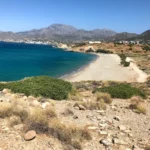
Lagoufa, situated just beyond the easternmost point of Makrigialos main beach, is located about 59km southeast of Agios Nikolaos and 24km east of Ierapetra. It is composed of two neighboring coves close to the upscale hotels of Makrigialos. The first cove boasts fine golden sand and shallow, azure waters, and is well-equipped with amenities such as umbrellas, bars, showers, and water sports facilities, courtesy of the nearby hotel. Despite its seemingly private nature, the beach is accessible to all as there are no privately owned beaches in Greece.
Entry to the Lagoufa beaches can be gained either via the hotels or by traversing the rocky eastern edge of Makrigialos beach, a journey that requires a brief walk through shallow waters. From the first cove, a wooden walkway leads to the beach furthest east. Below this walkway, tiny beaches have formed in the rocky limestone, and in certain areas, fresh water can be seen seeping from the rocks or sand.
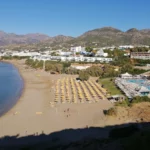
Lagada, positioned 29km to the east of Ierapetra, 62km southeast of Agios Nikolaos, and 6km east of Makrigialos, nestles within a verdant valley rich with olive groves and flanked by the towering Thripti mountains. In recent years, the area has seen the development of a few hotels and rental properties, yet the beach has managed to maintain its secluded charm.
To reach Lagada from Makrigialos, travel along the Sitia road and look out for the signs for Moni Kapsa. Within 500-800m, you’ll spot numerous greenhouses with the expansive Lagada beach to your right. Several roads starting near the greenhouses will lead you straight to the beach.
Lagada’s beach is characterized by its small pebbles and crystalline water. It’s entirely unpopulated and devoid of any facilities, making it a perfect getaway for naturists and campers. There are a handful of spots with tamarisk trees for shade. Towards the west, the Andromilos torrent cools the water. The beach, which is exposed to the southern winds, is recognized as an excellent spot for windsurfing in Crete, despite the rocky seabed posing some risks.

Makrigialos, a small town nestled near the exit of Pefki canyon, is situated 58km southeast of Agios Nikolaos and 23km to the east of Ierapetra. From its humble beginnings as a basic harbour in the 1950s with no connecting roads, Makrigialos has experienced considerable growth and is now the premier tourist hotspot in southeast Crete. The town is made up of two connected settlements, Makrigialos and Analipsi. There are a variety of accommodations, eateries, supermarkets, bakeries, ATMs, and medical facilities available for visitors.
Makrigialos’ growth is primarily attributed to its stunning beaches, tranquil shallow seas, and the majestic scenery of the Thripti Range to the north. The main beach, known as Makrigialos, Hani, or Long Beach, is located in Analipsi and stretches 1km. This well-maintained, narrow beach features fine golden sand and is surrounded by numerous cafes and restaurants. With its shallow, calm waters and warm temperatures even in winter, it is particularly suited for families and children.
To the west of the town beyond the port lies the lesser-known Kalamokanias beach with its unique coarse sand. North of the port in Katovigli, a small sandy beach extends from Makrigialos beach. This beach, also known as Katovigli or Limanaki, is equipped with free umbrellas and other amenities. The area is known for the ruins of a 2nd-century Roman villa, including baths and mosaics, a unique feature in eastern Crete. On the other side of the town are the two bays of Lagoufa, situated next to two large hotels.
Makrigialos is the ideal base for exploring the wider area, with its beautiful beaches stretching from Ferma to Goudouras and the surrounding villages. Outdoor enthusiasts will enjoy walking in the Pefki canyon or the lush Orino Gorge. In the town itself, visitors can explore local churches, the Roman Villa in Katovigli, and the Minoan villa at Plakakia, built between 1500-1450BC in the style of Minoan palaces. While nightlife is not particularly vibrant, there are several beach bars available. A leisurely walk to the Makrigialos harbour provides a picturesque view of the boats and local fishermen.
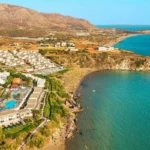
Venture from Makrigialos towards Goudouras, and post Lagada, take a right onto a dirt path that guides you to the greenhouses located on the petite peninsula at the eastern extremity of the bay. Continue along this path, past the greenhouses, to discover the secluded pebbly beach of Spilia, home to a small cave. This spot is typically deserted, though unfortunately, streams often carry litter here. Proceeding westward along the road, you’ll soon reach the remote sandy beach of Psalidia, named after the Greek word for scissors, a reference to the bay’s shape. The surrounding landscape is arid, dotted with low sand dunes and shrubs. However, come September, it transforms into a haven of white sand daffodils. Furthermore, a coastal walk from Psalidia to Lagada rewards you with spectacular rock formations, perfect for photography.
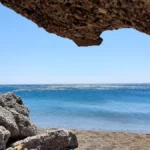
Ammoudi, situated 66km southeast from Agios Nikolaos and 29km east from Ierapetra, lies adjacent to the thoroughfare linking Makrigialos to Goudouras. The prominent beach in this vicinity, known as Spilia Drakou (Dragon’s Cave), owes its name to a massive cave situated 500m north of the beach and the identically named tavern next to it. Two additional secluded coves lie to the west of Dragon’s Cave beach, accessible either on foot or via a dirt track.
The beaches, hidden jewels not easily visible from the road, boast beautiful golden sand. To find the beach, you must halt upon spotting the Dragon’s Cave tavern and tread the narrow path leading to the sea, a short 3-minute walk. The secluded area is a perfect spot for families, however, it is not suitable for naturism as many locals frequent this place with their families. For more seclusion, you could stroll to the nearby coves to the west. The beaches are encompassed by towering cliffs and smooth white limestone rocks, with sandy seabeds.
In the absence of a car, you could avail the bus service that runs between Ierapetra and Goudouras, keeping in mind that the frequency of buses is not high. Therefore, ensure you are well-versed with the exact routes before embarking on your journey.
The cliffs in the area offer healthful clay that can be mixed with water and applied to the skin, serving as a natural spa when left to dry.

Situated on the western side of the Makrigialos settlement, Kalamokanias is 57km southeast of Agios Nikolaos and 22km east of Ierapetra. It rests on the western flank of Katovigli hill, which towers over the harbour area. The area is named Kalamokanias after the migratory stilt bird (Himantopus himantopus) – a red-legged creature resembling a miniature stork that frequents local streams.
The beach at Kalamokanias is tranquil, featuring coarse black sand that doesn’t cling to the skin. While not extensively developed, it offers some amenities including tamarisk trees for shade and a few taverns and rental rooms. Mainly frequented by locals, it provides a respite from the more tourist-heavy beach of Makrigialos.
To reach Kalamokanias from Ierapetra, make a right turn toward the sea just 100m before entering Makrigialos. Additionally, a coastal road links the beach with the local harbour.
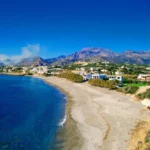
Kalo Nero, a small village nestled in one of eastern Crete’s most rugged terrains, is situated near Kapsa Monastery, 68 km south of Agios Nikolaos and 33 km east of Ierapetra. This village is positioned at the exit point of a rocky canyon. You’ll find the Panagia church (1881) here, built by the Pervolakia village residents for their winter stay when they brought their livestock for grazing. This church was built over an older chapel from 1461, which belonged to Kapsa Monastery.
The village is home to numerous freshwater springs, hence its name Kalo Nero, meaning Good Water; quite unusual for such a dry region. This place offers three secluded beaches perfect for a quiet swim. The first beach, Koutsounari (not to be confused with the Koutsounari near Agios Ioannis), is accessible by a short trail. This isolated beach has pebbles and clear water, with large rocks scattered on the seabed in certain areas.
Staousa, the main beach, is separated from Koutsounari by a few rocks. It’s a beautiful spot with fine pebbles and turquoise waters, its highlight being a large cave on the east side that’s on the verge of collapse. Fresh water drips from the cave walls, and access to this beach is simplified by a concrete path with stairs built by locals.
The third beach, Angelou, primarily serves as a local boat harbour, safeguarded from southwesterly winds. It’s a serene spot with small pebbles and rocks on the seabed. The rugged mountainous backdrop perfectly complements the picturesque boats and the blue sea’s hues.
Just 150m west of Kalo Nero lies the small Lygidi settlement at the cape of the same name, surrounded by small olive groves. A narrow bay with a western orientation is formed at the exit of a small stream. This bay hosts the lesser-known rocky beach, Mikro Limanaki (Little Harbour), which is easily accessible but hidden from the main road’s view.
You can reach Kalo Nero from Makrigialos via the road leading to Goudouras. Alternatively, there is a bus service from Ierapetra to Goudouras; however, do check the bus timings.
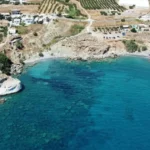
Situated 55km southeast of Agios Nikolaos and 20km east of Ierapetra, Koutsouras lies on the primary road between Ierapetra and Makrigialos. This coastal village is nestled in a valley surrounded by pine trees, greenhouses, and olive groves, resting on the southern slopes of Mount Thripti. Despite being equipped with a police station, pharmacy, clinic, hotels, restaurants, supermarkets, and more, Koutsouras maintains a serene atmosphere.
The village is bordered by beaches featuring coarse black sand and tranquil waters. The primary beach, located to the west of the village and adjacent to the old settlement, is well-maintained and dotted with tamarisk trees for shade. A secluded pebble beach near the village harbor offers a quieter option, situated 1.5km west next to the Apiganias woodland. Additionally, the family-friendly Koutsourelis beach, boasting sandy shores, lies 1km east of Koutsouras.
Sights to See
Koutsouras’ surrounding region, a heavenly landscape of Eastern Crete, is worth exploring. The southern slopes of Thripti are blanketed by a lush pine forest, providing an oasis in Lasithi’s arid landscape. Despite significant damage from a 1993 fire, the forest has gradually regenerated. The Apiganias park, 1.5km west of the village, offers a glimpse of the pine trees and also hosts cultural events. This park also marks the end of the Red Butterflies gorge, a unique canyon filled with pine trees and fresh water springs. For a complete experience, consider visiting the village Orino on Mount Thripti, which marks the starting point of the gorge.
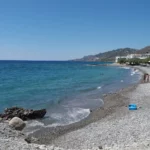
The Kapsas Monastery, an ancient religious site, is situated 37km southwest of Sitia and 32km east of Ierapetra, nestled between Makrigialos and Goudouras. It is perched on the cliffs close to the mouth of the majestic Pervolakia Gorge. The monastery can be accessed via the paved road connecting Makrigialos and Goudouras, with infrequent bus services also available from Ierapetra.
A secluded beach, characterized by its crystal-clear blue waters and large round pebbles, lies at the exit of the canyon. Despite its proximity to the road, the beach is isolated, offering the shade of several tamarisk trees. However, nudism is not allowed, and any attempt may invite trouble from the monks. The unique charm of this location lies in swimming amid the raw Cretan landscape, with its rugged rocks and caves.
Originating from the 13th century, the monastery was initially established by hermits, only to be ravaged by pirates in 1471. It was later reclaimed by the locals, including a certain Giovanni Capsas. Presently, it operates under the aegis of the Toplou Monastery and is devoted to the “Beheading of John the Baptist”, with celebrations held every year on August 29th. Legend has it that the holy man Iosif Georgoulakis, also known as Gerontogiannis, who was believed to perform miracles, once resided in a cave near the monastery.
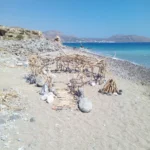
No results available
Reset© All rights reserved. Crete Locals